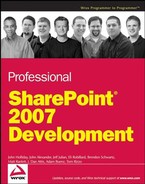14.7. Summary
InfoPath form templates are packaged in ZIP files with an .XSN extension. They contain a manifest that describes all aspects of the form and a schema that describes the data that the form recognizes. When building SharePoint solutions that rely on form data, this is the most important part of the form template. The data source is the heart of any InfoPath form, and is probably the best starting point when designing a form from scratch. A form can have one primary data source, also called a data connection, and many secondary data sources that link to external data.
SharePoint 2003 offered form libraries that could surface selected form data fields as columns, allowing end users to filter and view form data without having to resort to the original form. These columns were unidirectional, meaning that once they were edited in the form library, they could not be written back to the underlying form. Windows SharePoint Services 3.0 form data fields are now bidirectional, allowing for greater consistency in the gathering of form data.
InfoPath form security involves three basic scenarios, which map to the three underlying security models, namely restricted, domain, and full trust modes. Restricted mode forms are used for simple data gathering. Domain forms are limited to data sources within the same domain. Fully trusted forms can run managed code but must first be installed by an administrator.
Form publishing is like compiling source code. InfoPath validates the form and then transforms it as appropriate for the target execution environment. When published to a SharePoint site, a form template is updated to reflect its new location and the modified template is attached to the form library as the document template for that library. When a new form is created, the form data file contains a reference to the form library.
InfoPath 2007 can publish a form to a SharePoint document library and adds the ability to publish a form directly to a content type. Content type publishing eliminates the need for the form designers to be involved in redeploying a form to another form library, thereby relieving the IT bottleneck for site administrators.
InfoPath Forms Services greatly extends the reach of electronic forms because users are no longer required to have the InfoPath client application installed in order to fill out a form. With InfoPath Forms Services enabled, users can edit many forms directly from within their web browser. Browser-based forms have restricted functionality and are not intended to replace client-based forms. Client-based forms may still be required to implement certain types of solutions.
